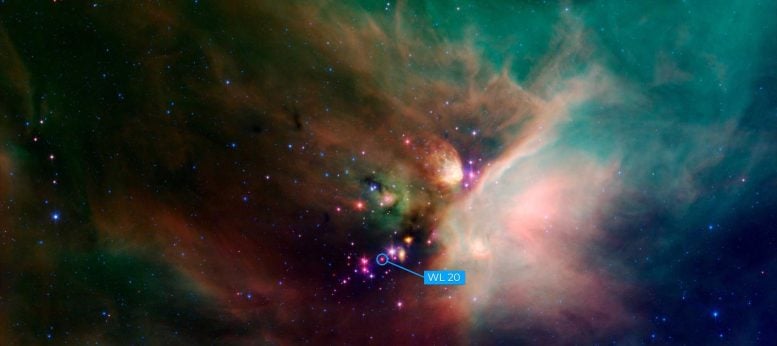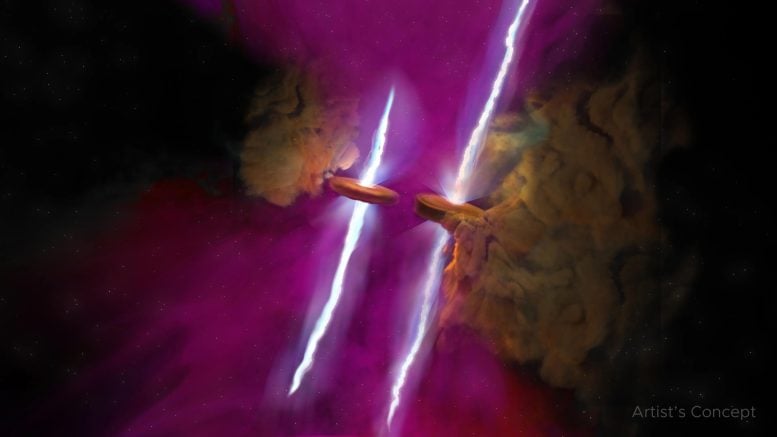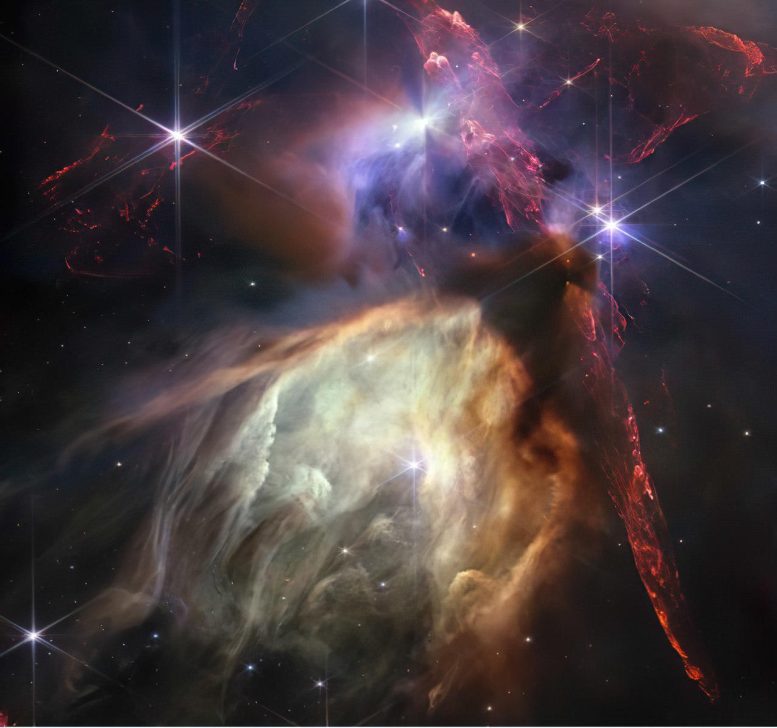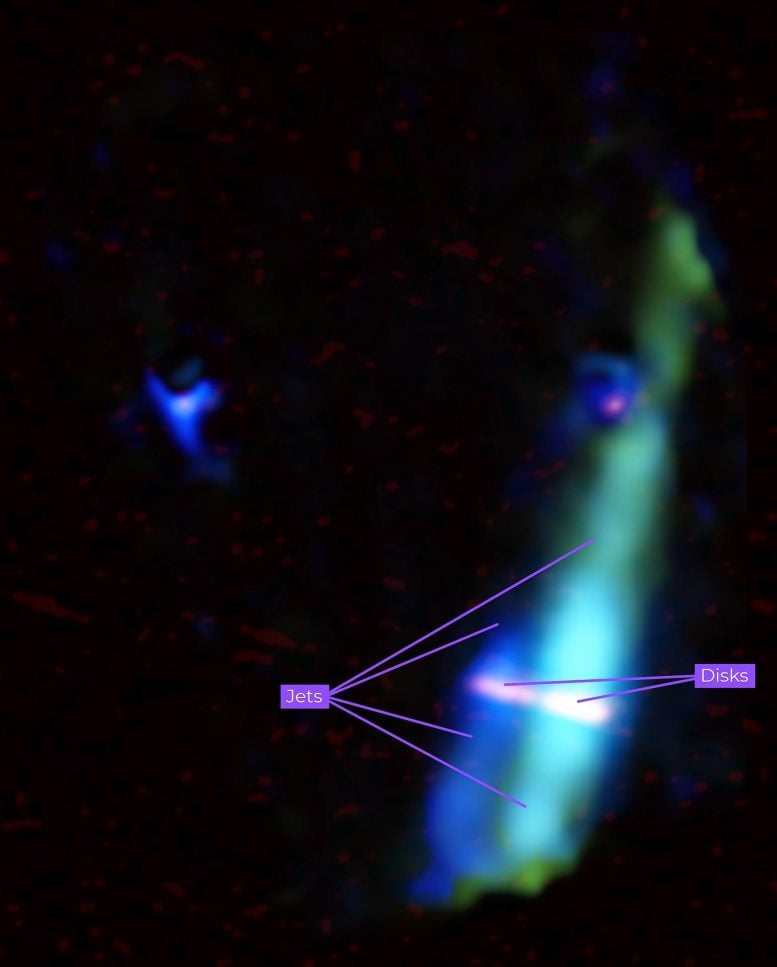
Credit: NASA-JPL/Caltech
Using the James Webb Space Telescope’s MIRI, astronomers discovered that WL 20S, previously thought to be a single star, is actually a twin star system.
Further observations by ALMA revealed the presence of gas and dust disks around both stars, indicating ongoing planet formation and providing new insights into stellar life cycles.
Astronomers recently got a big surprise from NASA’s James Webb Space Telescope when they turned the observatory toward a group of young stars called WL 20. The region has been studied since the 1970s with at least five telescopes, but it took Webb’s unprecedented resolution and specialized instruments to reveal that what researchers long thought was one of the stars, WL 20S, is actually a pair that formed about 2 million to 4 million years ago.

Unveiling the Twins With MIRI
The discovery was made using Webb’s Mid-Infrared Instrument (MIRI) and was presented recently at the 244th meeting of the American Astronomical Society. MIRI also found that the twins have matching jets of gas streaming into space from their north and south poles.
“Our jaws dropped,” said astronomer Mary Barsony, lead author of a new paper describing the results. “After studying this source for decades, we thought we knew it pretty well. But without MIRI we would not have known this was two stars or that these jets existed. That’s really astonishing. It’s like having brand new eyes.”

Surprising Findings From ALMA
The team got another surprise when additional observations by the Atacama Large Millimeter/submillimeter Array (ALMA), a group of more than 60 radio antennas in Chile, revealed that disks of dust and gas encircle both stars. Based on the stars’ age, it’s possible that planets are forming in those disks.
The combined results indicate that the twin stars are nearing the end of this early period of their lives, which means scientists will have the opportunity to learn more about how the stars transition from youth into adulthood.
“The power of these two telescopes together is really incredible,” said Mike Ressler, project scientist for MIRI at NASA’s Jet Propulsion Laboratory and co-author of the new study. “If we hadn’t seen that these were two stars, the ALMA results might have just looked like a single disk with a gap in the middle. Instead, we have new data about two stars that are clearly at a critical point in their lives, when the processes that formed them are petering out.”

Credit: U.S. NSF; NSF NRAO; ALMA; NASA/JPL-Caltech; B. Saxton
Stellar Jets
WL 20 resides in a much larger, well-studied star-forming region of the Milky Way galaxy called Rho Ophiuchi, a massive cloud of gas and dust about 400 light-years from Earth.
In fact, WL 20 is hidden behind thick clouds of gas and dust that block most of the visible light (wavelengths that the human eye can detect) from the stars there. Webb detects slightly longer wavelengths, called infrared, that can pass through those layers. MIRI detects the longest infrared wavelengths of any instrument on Webb and is thus well equipped for peering into obscured star-forming regions like WL 20.
Radio waves can often penetrate dust as well, though they may not reveal the same features as infrared light. The disks of gas and dust surrounding the two stars in WL 20S emit light in a range that astronomers call submillimeter; these, too, penetrate the surrounding gas clouds and were observed by ALMA.

Credit: U.S. NSF; NSF NRAO; ALMA; NASA/JPL-Caltech; B. Saxton; Carnegie/Caltech
But scientists could easily have interpreted those observations as evidence of a single disk with a gap in it had MIRI not also observed the two stellar jets. The jets of gas are composed of ions, or individual atoms with some electrons stripped away that radiate in mid-infrared wavelengths but not at submillimeter wavelengths. Only an infrared instrument with spatial and spectral resolution like MIRI’s could see them.
ALMA can also observe clouds of leftover formation material around young stars. Composed of whole molecules, like carbon monoxide, these clouds of gas and dust radiate light at these longer wavelengths. The absence of those clouds in the ALMA observations shows that the stars are beyond their initial formation phase.
“It’s amazing that this region still has so much to teach us about the life cycle of stars,” said Ressler. “I’m thrilled to see what else Webb will reveal.”
James Webb Space Telescope
The James Webb Space Telescope (JWST), often hailed as the successor to the Hubble Space Telescope, represents a giant leap forward in our ability to observe the universe. Launched on December 25, 2021, JWST is the largest, most powerful space telescope ever built, designed to peer deeper into the cosmos than ever before. It operates primarily in the infrared spectrum, allowing it to look through cosmic dust and gas to study the formation of stars and galaxies, observe planets around distant stars, and investigate the universe’s earliest galaxies.
This remarkable observatory, a collaborative effort led by NASA with significant contributions from the European Space Agency (ESA) and the Canadian Space Agency (CSA), aims to unravel the mysteries of our solar system, explore exoplanets in new detail, and understand the structures and origins of our universe.